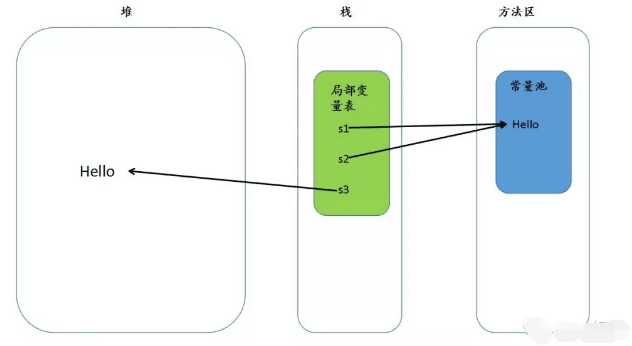标签:内容 demo tar http ref src com color 定义
今天课堂测试做了几道String的练习题,做完直接心态爆炸......
整理自下面两篇博客:
https://www.cnblogs.com/marsitman/p/11248001.html
https://www.cnblogs.com/aspirant/p/9193112.html
首先先来看看下面的代码:
public class StringTest { public static void main(String[] args){ String s1="Hello"; String s2="Hello"; String s3=new String("Hello"); System.out.println("s1和s2 引用地址是否相同:"+(s1 == s2)); System.out.println("s1和s2 值是否相同:"+s1.equals(s2)); System.out.println("s1和s3 引用地址是否相同:"+(s1 == s3)); System.out.println("s1和s3 值是否相同:"+s1.equals(s3)); } }
打印结果如下:
s1和s2 引用地址是否相同:true s1和s2 值是否相同:true s1和s3 引用地址是否相同:false s1和s3 值是否相同:true
我们可以看到 在java中,比较String有两种方式,一种是用"==",另一种是用s.equals()方法。
那么这两种方法有什么不同呢?
上面程序中的"=="是判断两个对象引用的地址是否相同,也就是判断是否为同一个对象,s1与s2 返回为true,s1与s3返回则是false。说明s1与s2 引用的同一个对象的地址,s3则与其它两个引用不是同一个对象地址。
而s.equals()方法则是判断字符串的内容是否相等,只要内容相等就返回true,当然,地址相等就更不用说了,肯定返回true。
Java为了避免产生大量的String对象,设计了一个字符串常量池。工作原理是这样的,创建一个字符串时,JVM首先为检查字符串常量池中是否有值相等的字符串,如果有,则不再创建,直接返回该字符串的引用地址,若没有,则创建,然后放到字符串常量池中,并返回新创建的字符串的引用地址。所以上面s1与s2引用地址相同。
那为什么s3与s1、s2引用的不是同一个字符串地址呢?
注意看 s3的定义方法:
String s3=new String("Hello");
JVM首先是在字符串常量池中找"Hello" 字符串,如果没有创建字符串常量,然后放到常量池中,若已存在,则不需要创建;当遇到 new 时,还会在内存(不是字符串常量池中,而是在堆里面)上创建一个新的String对象,存储"Hello",并将内存上的String对象引用地址返回,所以s3与s1、s2引用的不是同一个字符串地址。 内存结构图如下:

从内存图可见,s1与s2指向的都是常量池中的字符串常量,所以它们比较的是同一块内存地址,而s3指向的是堆里面的一块地址,说的具体点应该是堆里面的Eden区域,s1跟s3,s2跟s3比较都是不相等的,都不是同一块地址。
拓展问题:
请问String s = new String("xyz");产生了几个对象?
在String的工作原理中,已经提到了,new一个String对象,是需要先在字符串常量中查找相同值或创建一个字符串常量,然后再在内存中创建一个String对象,所以String str = new String("xyz"); 会创建两个对象。
下面看几道习题:
1、
public class Test { public static void main(String[ ] args) { String s1 = new String("Welcome to Java!"); String s2 = new String("Welcome to Java!"); if (s1 == s2) System.out.println("s1 and s2 reference to the same String object"); else System.out.println("s1 and s2 reference to different String objects"); } }
s1 and s2 have different contents
虽然常量池中已经存在"Welcome to Java!"了,但s2 new 时,还会在内存(不是字符串常量池中,而是在堆里面)上创建一个新的String对象,存储"Welcome to Java!",并将内存上的String对象引用地址返回给s2,所以s1和s2引用地址不同。
2、
public class Test { public static void main(String[ ] args) { String s1 = "Welcome to Java!"; String s2 = s1; if (s1 == s2) System.out.println("s1 and s2 reference to the same String object"); else System.out.println("s1 and s2 reference to different String objects"); } }
s1 and s2 reference to the same String object
常量池中已经存在"Welcome to Java!"了,不需要再创建,直接返回该字符串的引用地址给s2,所以s1和s2有相同的引用地址。
再来看这样一个问题:
public class StringDemo4 { public static void main(String[] args) { String s1 = "hello"; String s2 = "world"; String s3 = "helloworld"; System.out.println(s3 == s1 + s2);// false System.out.println(s3.equals((s1 + s2)));// true System.out.println(s3 == "hello" + "world");//false System.out.println(s3.equals("hello" + "world"));// true } }
equals()比较方法不解释,比较值,均相等,均为true。
总结:
String s = new String(“hello”)会创建2(1)个对象,String s = “hello”创建1(0)个对象。
注:当字符串常量池中有对象hello时括号内成立!
字符串如果是变量相加,先开空间,在拼接。
字符串如果是常量相加,是先加,然后在常量池找,如果有就直接返回,否则,就创建。
Java中String直接赋字符串和new String的一些问题
标签:内容 demo tar http ref src com color 定义
原文地址:https://www.cnblogs.com/wkfvawl/p/11656137.html